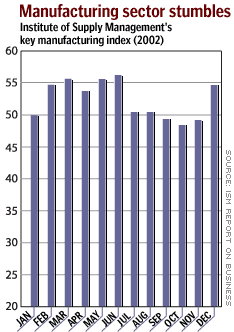NEW YORK (CNN/Money) -
Manufacturing activity in the United States expanded for the first time in four months in December, the nation's purchasing managers said Thursday, though economists weren't yet convinced that happy days had returned for the long-suffering factory sector.
The Institute for Supply Management said its index of manufacturing activity rose to 54.7 from 49.2 in November.
Any reading under 50 percent indicates contraction in the sector. Economists, on average, expected an index reading of 50.1, according to Briefing.com.

"The manufacturing sector rebounded in December," said Norbert Ore, chairman of the ISM's business survey committee. "The question at this point is whether the manufacturing sector can continue to gather momentum during the first quarter of 2003."
The report helped lift U.S. stock prices, while Treasury bond prices dropped.
Though the report was good news, other recent economic data have been fairly negative, inspiring President Bush to announce Thursday that he would unveil an economic stimulus package of tax cuts and spending, which could cost as much as $300 billion, next week.
Late last year, Bush fired some key members of his economic advisory team who had been criticized for failing, in some observers' eyes, to respond adequately to economic weakness. Bush must certainly remember his father's 1992 re-election campaign, which failed in part because of charges that he was unconcerned about the economy.
The manufacturing sector has been struggling since late 2000, when businesses abruptly stopped spending on factory improvements and new technology. The industry fell into an 18-month-long recession, the precursor to a broader U.S. recession that began in March 2001.
Manufacturing bounced back earlier this year, growing for seven straight months, but fell back into contraction in September as businesses curtailed spending again after a brutal stock selloff.
Few economists expected the industry to recover so strongly in December, especially given last week's report from the The National Association of Purchasing Management-Chicago that its gauge of manufacturing activity in the Midwest had slipped in December, and given the Commerce Department's recent report that orders for long-lasting manufactured goods dropped sharply in November.
"A turnaround in manufacturing has not been signaled anywhere else, so I guess I'm not as excited about this number as the markets seem to be," said Brown Brothers Harriman economist Lara Rhame, a former Federal Reserve economist. "I would like to see this confirmed in another month of data."
December's gain in the ISM index was driven by a big jump in new orders -- that index rose to 63.3 percent from 49.9 percent in November.
The ISM employment index rose to 47.4 percent from 43.8 percent, meaning manufacturers are still laying off workers, but not as quickly.
If businesses are beginning to spend money again, manufacturing activity -- and hiring -- could rebound in 2003. But uncertainties about the possibility of a U.S. war in Iraq are still likely keeping many businesses on the sideline, and the economy might not turn around until those uncertainties clear up.
That uncertainty led the Fed to slash its target for short-term interest rates to new 40-year lows last year, and lingering geopolitical questions could inspire the central bank to keep rates low in 2003, keeping borrowing costs low and possibly fueling some business investment later in the year.
"If low interest rates mean [Thursday's ISM] reading can be sustained, then the economy appears set for takeoff," said Ian Shepherdson, chief U.S. economist at High Frequency Economics in Valhalla, N.Y.

|

